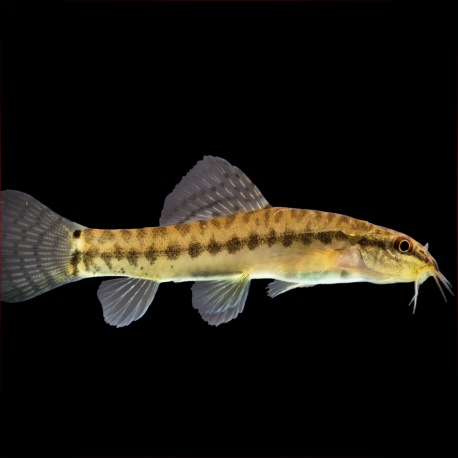More info
Datasheet
| Minimum Tank Size | 90 litres / 23.78 US gallons |
| Maximum Size | 7.5cm / 2.95inches |
| Temperature | 20°C / 68.00°F - 26°C / 78.80°F |
| Hardness | 2.02dgH / 36ppm - 12.05dgH / 215ppm |
| pH | 6.0-7.5 |
General Description
Paracanthocobitis mooreh is a small fish species with distinguishable characteristics such as an incomplete lateral line, small vertical blotches along the lateral line, and 4-5 dark bands on the caudal fin. It belongs to the family Nemacheilidae and is endemic to the Godavari, Krishna, and Kaveri river systems in western and southern India. The species displays a preference for streams and small rivers with sandy substrates and debris accumulation.
Aquarium Setup
This species requires a well-maintained tank with ample cover and does not pose a threat to softer-leaved plants. An ideal habitat setup would mimic a slow-moving section of a stream with a sandy substrate, water-worn boulders, driftwood, dried leaves, and attached aquatic plants. While high water movement is not crucial, creating a hill stream-type aquascape with rocky structures can also promote the well-being of P. mooreh.
Behaviour
Paracanthocobitis mooreh is generally non-aggressive and can coexist peacefully with various other species in the aquarium trade. It thrives in the company of similarly-sized, schooling cyprinids, loaches like Lepidocephalichthys and select Nemacheilus spp. In a hill stream environment, compatible tankmates include rheophilic genera such as Gastromyzon, Pseudogastromyzon, Beaufortia, and Sewellia, while more aggressive nemacheilids like most Schistura spp. should be avoided.
Feeding and Diet
In its natural habitat, P. mooreh likely feeds on insect larvae such as larval chironomids and ephemeropterans. In captivity, they readily accept sinking dried foods but should also be offered a diet of small live or frozen foods like Daphnia, Artemia, and chironomid larvae (bloodworm) to ensure proper nutrition.
Reproduction & Dimorphism
There is currently no recorded information on the reproduction habits of Paracanthocobitis mooreh. However, adult males of the species are expected to be noticeably slimmer than females, indicating potential sexual dimorphism.
Habitat and Distribution
The species is exclusively found in the river systems of Godavari, Krishna, and Kaveri in India. Its habitat preference includes stretches of streams and small rivers with a substrate of open sand, mixed cobbles, rocks, boulders, and accumulated leaf litter, making it a vital part of the local aquatic ecosystem.

